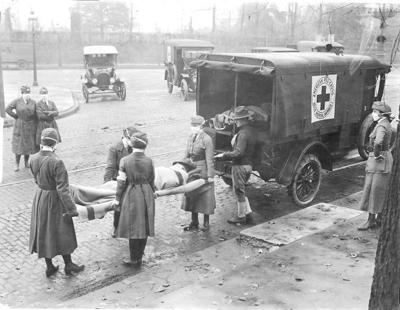51şÚÁĎ held down the death toll of the world's worst pandemic by closing public places, including churches and schools, and prohibiting dances and banquets.
People are also reading…

Members of the Red Cross Motor Ambulance Corps in 51şÚÁĎ transport influenza patients from a house at Etzel and Page avenues. The Spanish Flu epidemic killed 1,703 in 51şÚÁĎ in fall and winter 1918-19, but the city's draconian order closing schools, churches and many other public places helped to make the local death rate the lowest among the nation's largest cities.
Look Back: 1918 Spanish Flu epidemic

Members of the Red Cross Motor Ambulance Corps in 51şÚÁĎ transport influenza patients from a house at Etzel and Page avenues. The Spanish Flu epidemic killed 1,703 in 51şÚÁĎ in fall and winter 1918-19, but the city's draconian order closing schools, churches and many other public places helped to make the local death rate the lowest among the nation's largest cities.

U.S. Rep. Jacob Meeker, who died Oct. 16, 1918, of Spanish Flu in Jewish Hospital. He had toured Jefferson Barracks the week before and probably contracted it there. Seven hours before he died, he married his secretary, Alice Redmon, in the hospital. Meeker, a Republican, represented part of 51şÚÁĎ. (Post-Dispatch)

St. Mary's Infirmary, at 1536 Papin Street, one of more than 50 hospitals in 51şÚÁĎ at the time of the Spanish Flu epidemic. Among patients who died there of the flu were Clara Breunig of 2585 Hebert Street, her son Edward, 5, and her daughter, Dolores, 4. They died within three days of each other in December, 1918, and were buried in Hermann, Mo. The hospital, built in 1877 and a predecessor to St. Mary's Health Center in Richmond Heights, closed in 1966 and later was a state prison honor center. Long vacant, it is partially collapsed. (Post-Dispatch)

At left is Barnes Hospital, Kingshighway and Euclid Avenue, in 1921. Among the patients who died there of Spanish Flu was Dr. Roscoe Healy, 24, who contracted it while treating patients as a staff doctor. He died Dec. 7, 1918. The building at rear right was the Washington University School of Medicine. That building and some of the hospital remain as parts of the Washington University Medical Center. (Post-Dispatch)

51şÚÁĎ City Hospital, 1515 Lafayette Avenue, circa 1940. The hospital cared for many patients during the Spanish Flu epidemic in 1918-19. The hospital, built in 1907 to replace one that was destroyed in the 1896 tornado. The city closed it in 1985, and has been converted into condos. (Post-Dispatch)

Members of the Red Cross Motor Ambulance Corps prepare to deliver broth and food to influenza patients in 51şÚÁĎ during the Spanish Flu epidemic of 1918-19.

The hospital at Jefferson Barracks in south 51şÚÁĎ County around the time of World War I. American soldiers spread the Spanish Flu to Europe, and the barracks was the likely source of the outbreak in 51şÚÁĎ. On the day Dr. Max Starkloff, city health commissioner, ordered the closing of schools and most public places, two soldiers died at the base hospital.
(Missouri History Museum)

Alice Redmon, who married U.S. Rep. Jacob Meeker in Jewish Hospital on Oct. 16, 1918, the day he died of Spanish Flu. Redmon, a widow, was his secretary. She formerly had been secretary of the Republican City Central committee. (Post-Dispatch)

Ida Britton and Grace Semple, both members of the Red Cross Motor Ambulance Corps in 51şÚÁĎ, wear masks while caring for influenza patients during the Spanish Flu epidemic.

Mayor Henry Kiel, who served in office from 1913 to 1925, backed Dr. Max Starkloff in the draconian order closing many public places during the Spanish Flu epidemic. Kiel said many businessmen lobbied hard to loosen the order, but he stuck with the health commissioner. (Post-Dispatch)

Dr. Max Starkloff, city health commissioner for 30 years. On Oct. 7, 1918, Starkloff ordered and enforced the closing of schools, churches, taverns, pool halls and other public places to reduce the spread of Spanish Flu, a deadly influenza that killed many more people worldwide than did World War I. His effort is credited with keeping the 51şÚÁĎ death rate the lowest among major American cities. (Post-Dispatch)

A ward in Barnes Hospital in 1914, the year the hospital opened. Information on the photograph describes the scene as "one of the spacious and brilliantly lighted medical wards" at the new hospital. (Post-Dispatch)











